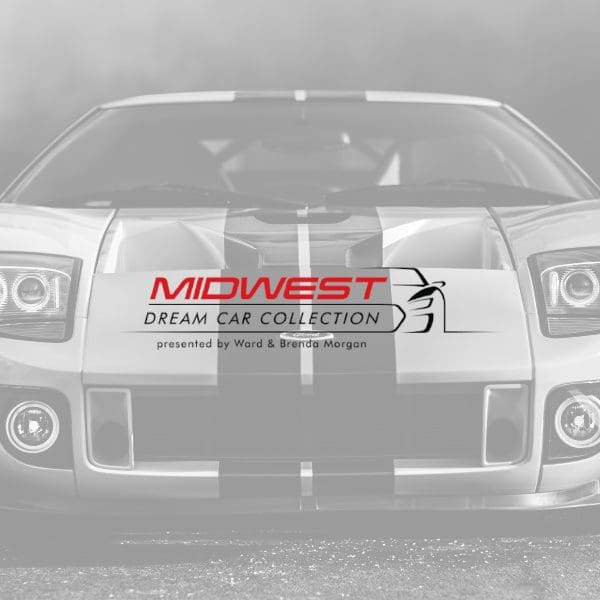
In the words of one historian, “Its aim was right, but the target moved.” That’s the story of Ford Motor Company’s Edsel Division.
Unmistakable on the road, the Edsel is easily recognized by the massive protruding “horse collar” grill, which earned it such unflattering descriptions as “It looks like an Oldsmobile sucking a lemon.” Whatever your thoughts, these iconic vehicles from the late 1950s are a sight to see. Unique from every angle and distinct from their counterparts, they have become an important part of automotive history.
Edsel Pacer convertibles like the one featured in our museum were produced only for the 1958 model year and had a base sticker price of $3,028 (about $26,500 today). With only 1,876 produced, they have become a highly sought-after car in the collector market.
The Pacer was a step up from the base Edsel Ranger and included such amenities as contoured seats, nylon upholstery, color-keyed rubber floormats, a “cyclops eye” rotating-drum speedometer (which would glow red when a pre-set speed was exceeded), and special stainless-steel side-trim pieces. Most were equipped with a three-speed automatic transmission with an optional Teletouch push-button transmission control—uniquely, in the center hub of the steering wheel, where most cars had their horn buttons. The location of these selector buttons was advertised as making shifting safer and easier without the need to take your hands off the wheel. However, many people accidently shifted gears while trying to honk the horn, with disastrous results.
Hoping to compete with General Motors’ five car divisions, Ford laid out plans in the early 1950s for a separate Continental Division and a second, medium-priced make to strengthen Ford and Mercury sales. They decided that an entirely new car division and an entirely new car were what they needed. The development of the Edsel was kept under extremely close security, and people were tight-lipped about it even within the company. It was known only as the “E car” until nearly production time.
To bolster sales, one of the biggest marketing campaigns of the era was launched, which resulted in an estimated 2.5 million people visiting dealer showrooms on September 4, 1957—or E-Day, the day the Edsel was unveiled. The hype actually raised people’s expectations so high that the car couldn’t possibly live up to them. In addition, when the Edsel was first conceived, mid-priced car sales were booming, but by the time it hit showroom floors in 1957, America was in a deep recession and people no longer wanted big, heavy, chrome-laden cars. They wanted smaller, more economical cars such as the American Motors Rambler or the Volkswagen Beetle. The Edsel was also described by the public as poorly put together—and it was, but so were most of the cars Detroit was putting out in that period. It didn’t help, either, that the cutting-edge transmission selector was troublesome and often didn’t work properly; Teletouch would be discontinued after the 1958 model year.
“Edsel” was a nod to Henry Ford’s only son, Edsel Ford. Edsel had served as president of the Ford Motor Company from 1919 until his death in 1943, at the young age of 49. The Ford family was very much against his name being used on the new car, and they made that publicly known. So the company reached out to others, including poet Marianne Moore, for suggestions. Moore suggested “Utopian Turtletop,” “Mongoose Civique,” and “Turcotinga.” Of the more than 6,000 names submitted, only “Ranger,” “Pacer,” “Corsair,” and “Citation” were selected, but these only for model names. Finally at the last minute, with no name settled on, board chairman Ernest R. Breech went against the Ford family’s wishes and decided to go with Edsel. Perhaps this was strike one against the new make.
The Edsel was produced from July 1957 until November of 1959 for three model years: 1958, ’59, and ’60. The 1958 line comprised the base or entry-level Ranger and the step-up Pacer model, both of which were based on the smaller Ford chassis and came equipped with powerful E-400 (361-CID) engines. These models were to fill the gap between Ford and Mercury Cars. The larger and more expensive Edsel Corsair and Citation models were based on the Mercury chassis and were equipped with massive E-475 (410-CID engines). They were positioned to fill the gap between Mercury and Lincoln cars. The model line-up also included three station wagons: the Roundup, Villager, and top-of-the-line Bermuda.
Following disappointing 1958 sales of only 63,110 (Ford had hoped for a minimum of 100,000), the 1959 models were drastically redesigned, basically becoming re-skinned Fords, and the models were reduced to three: the Ranger, the Corsair, and the Villager station wagon. Edsel production for 1959 was an abysmal 44,891, and Ford was hearing the car’s death rattle. The 1960 Edsel, offered in only the Ranger and Villager models, was nothing but a 1960 Ford with lipstick. Gone was the hallmark vertical grill. And only 2,846 Edsels had been built for that year when production was halted on November 19, 1959. All the 1960 models are extremely rare, but the Ranger convertible especially so: only 76 were produced. These 1960 convertibles easily command six figures when they come up for sale in today’s collector car market.
The Edsel story is a significant chapter in automotive history. After all was said and done, the Ford Motor Company lost $350 million on the Edsel (about $2.3 billion today). The right car at the wrong time, perhaps: but the Edsel may be getting the last laugh. They are now highly collectable and very valuable.
*The information in this document is provided by The Standard Catalog of American Cars. The full citation is listed below with where to find this information and more.
Gunnell, John A. (1982). Standard Catalog of American Cars 1946-1975. Krause Publications. ISBN 0-87341-027-0.
McCourt, Mark J. “Control Center, We Have Lift-Off.” Hemmings.com, Hemmings Motor News, Feb. 2008, www.hemmings.com/magazine/hmn/2008/02/Control-Center–We-Have- Lift-off/1579428.html
Signup for our newsletter to stay up-to-date and connected.